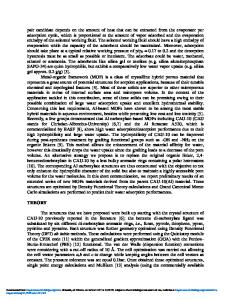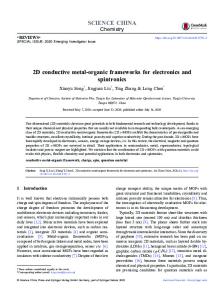Understanding the Mechanism of Hydrogen Adsorption into Metal Organic Frameworks
- PDF / 1,516,177 Bytes
- 6 Pages / 612 x 792 pts (letter) Page_size
- 100 Downloads / 350 Views
0885-A09-29.1
Understanding the Mechanism of Hydrogen Adsorption into Metal Organic Frameworks Tae-Bum Lee1, Daejin Kim1, Seung-Hoon Choi1*, Ji Hye Yoon2, Sang Beom Choi2 and Jaheon Kim2 1 Insilicotech Co. Ltd., A-1101 Kolontripolis, 210, Geumgok-Dong, Bundang-Gu, Seongnam-Shi 463-943, Korea 2 Department of Chemistry, Soongsil University, 1-1, Sangdo-5 Dong, Dongjak-Gu, Seoul 156-743, Korea *E-mail: [email protected] ABSTRACT Hydrogen adsorption mechanism into the porous metal-organic frameworks (MOFs) has been studied by density functional theory calculation. The selected functionals for the prediction of interaction energies between hydrogen and potential adsorption sites of MOFs were utilized after the evaluation with the various functionals for interaction energy of H2∙∙∙C6H6 model system. The adsorption energy of hydrogen molecule into MOFs was investigated with the consideration of the favorable adsorption sites and the orientations. We also calculated the second favorable adsorption sites by geometry optimization using every combination of two first absorbed hydrogen molecules. Based on the calculation of first and second adsorption sites and energies, it has been suggested that the hydrogen adsorption into MOFs follows a cooperative mechanism in which the initial metal sites initiate the propagation of the hydrogen adsorption on the whole frameworks. In addition, the interaction mode between the simple benzene ring with hydrogen is significantly changed when the benzene ring has been incorporated into the framework of MOFs. INTRODUCTION The Metal-Organic Frameworks (MOFs) has quickly caught attention as promising materials for the hydrogen storage due to their reversible and higher loading adsorption at moderate temperature and lower pressure compared with those of other materials [1]. However, the adsorption mechanism of hydrogen is not clear until now except that the presence of the aromatic linkers is seemingly favorable. In this regards, adsorption sites search based on molecular level and the elucidation of its adsorption mechanism are highly requested to design better storage materials for hydrogen [2].
0885-A09-29.2
COMPUTATIONAL DETAILS In order to investigate hydrogen adsorption into MOFs using density functional theory (DFT), the adequate functionals to represent the interaction of absorbate with absorbent, appropriate model to mimic the real structure, and the systematic optimization of geometry of hydrogen were required. We examined the interaction energy of H2∙∙∙C6H6 model using eight kinds of generalized gradient approximation (GGA) level density functional, BP, BOP, BLYP, PBE, RPBE, VWN-BP, PW91 and HCTH with double numeric polarization basis set in DMol3[3]. The screened three functionals (HCTH, PW91 and PBE) were utilized for the study of hydrogen adsorption into MOF-5, a representative structure of MOFs, after comparing with previous Møller-Plesset 2nd order perturbation (MP2) study [4]. Due to the intrinsic high symmetry of MOF-5, one side of its unit cell with the edge capped
Data Loading...











